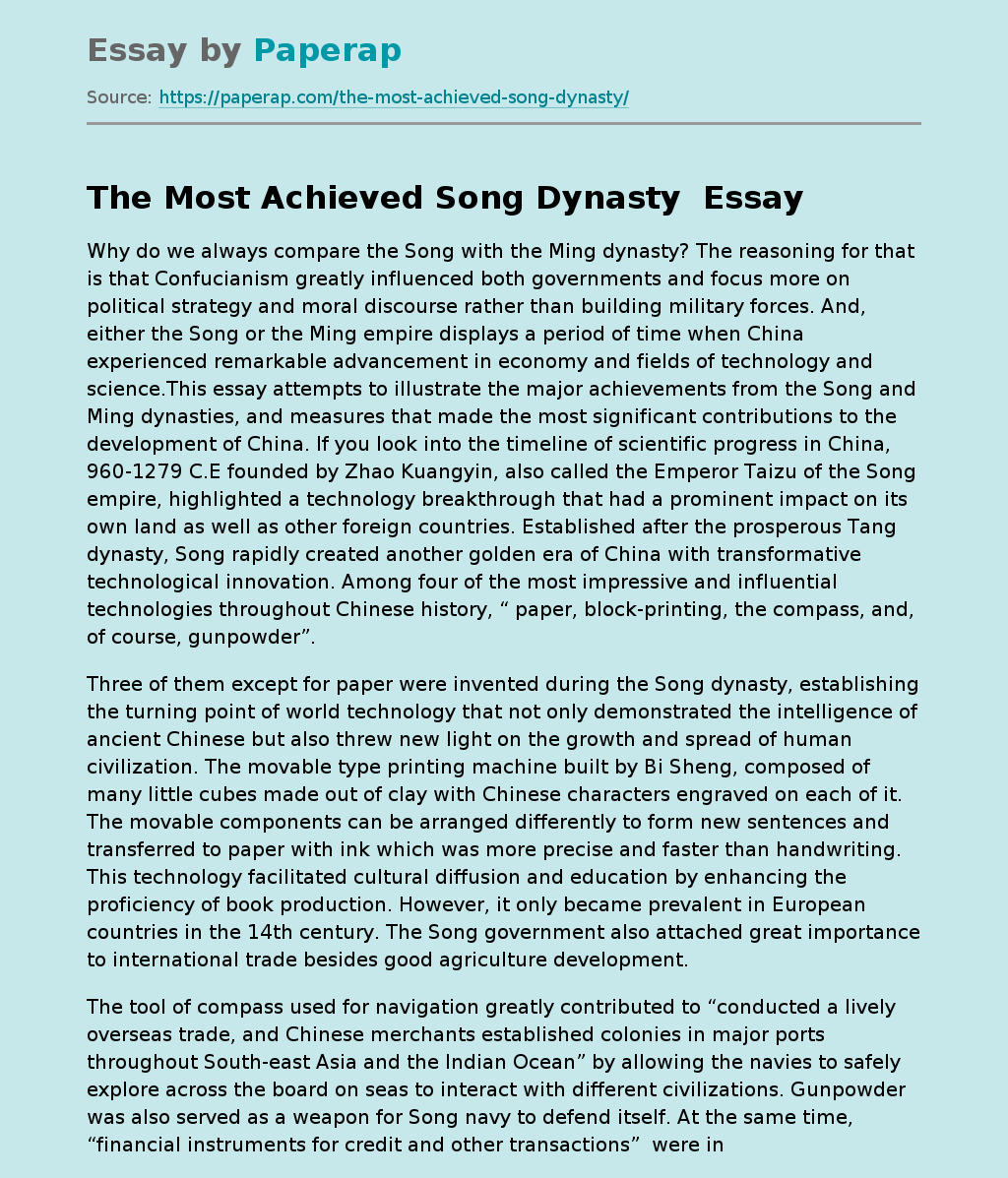The Most Achieved Song Dynasty
Why do we always compare the Song with the Ming dynasty? The reasoning for that is that Confucianism greatly influenced both governments and focus more on political strategy and moral discourse rather than building military forces. And, either the Song or the Ming empire displays a period of time when China experienced remarkable advancement in economy and fields of technology and science.This essay attempts to illustrate the major achievements from the Song and Ming dynasties, and measures that made the most significant contributions to the development of China.
If you look into the timeline of scientific progress in China, 960-1279 C.E founded by Zhao Kuangyin, also called the Emperor Taizu of the Song empire, highlighted a technology breakthrough that had a prominent impact on its own land as well as other foreign countries. Established after the prosperous Tang dynasty, Song rapidly created another golden era of China with transformative technological innovation. Among four of the most impressive and influential technologies throughout Chinese history, “ paper, block-printing, the compass, and, of course, gunpowder”.
Three of them except for paper were invented during the Song dynasty, establishing the turning point of world technology that not only demonstrated the intelligence of ancient Chinese but also threw new light on the growth and spread of human civilization. The movable type printing machine built by Bi Sheng, composed of many little cubes made out of clay with Chinese characters engraved on each of it. The movable components can be arranged differently to form new sentences and transferred to paper with ink which was more precise and faster than handwriting.
This technology facilitated cultural diffusion and education by enhancing the proficiency of book production. However, it only became prevalent in European countries in the 14th century. The Song government also attached great importance to international trade besides good agriculture development.
The tool of compass used for navigation greatly contributed to “conducted a lively overseas trade, and Chinese merchants established colonies in major ports throughout South-east Asia and the Indian Ocean” by allowing the navies to safely explore across the board on seas to interact with different civilizations. Gunpowder was also served as a weapon for Song navy to defend itself. At the same time, “financial instruments for credit and other transactions” were invented to encourage product exchange and market development by expanding an economic network. Move on to the Ming dynasty which was established eighty-nine years after Song collapsed, and became the last imperial dynasty ruled by the Chinese. A significant achievement under Ming was its strong naval power and advanced navigation technology. The western world exploration led by the great navigator Zheng He helped strengthen bonds between the Ming empire and the outside world. In 1405-1431, the well-known treasure ships were built for his voyages along with “28,000 crew and military personnel” covering from the Indian Ocean to the East African coast purposed to tribute diplomacy and trade.
During the early Ming dynasty, strong navies and the production of treasure ships in maritime trade maintained a well-developed global relationship and opened up international marketing just like Song. However, later on, the government rose awareness on the power that the merchants and court eunuchs had to control over the economy, intensified by the danger of Mongols they ended this successful overseas exploration. The connection between Ming and other countries became dependent on foreign representatives. The policy for merchant licenses also prohibited free trading and limited the number of new products that could be traded into Ming, which now differed from the massive global marketing in Song. On the other hand, the government advocated most concentration on agriculture. Abolishment of forced labor and enhancement in agricultural technology such as the production of “Pelton-type waterwheels; the foot-powered “dragon” chain pump for irrigation; and the fence”, supported the development of the handicraft industry.
“Huge and growing demand for porcelain, tea, silk, paper, and cotton textiles made the empire the world’s dominant economic engine”. Agriculture in Ming eventually developed into a new level that had never been reached before. Although the Song and the Ming dynasty are very alike in many ways. For example, their achievements in advanced interventions that significantly facilitated both international trades and agriculture development, and administration system influenced by Neo-Confucian to promote moral education and maintain the welfare of the citizens, the Song contributed to sustaining long-term international exchange markets in monetization with free merchants commercial activities in certain areas, which continued to improve the overall economy and absorb knowledge from the outside. However, the emperor of Ming Zhu Yuanzhang proposed the idea of equalizing development within the country to stabilize the economy and strictly limited business trading that slowed down economic growth.
The Most Achieved Song Dynasty . (2021, Dec 13). Retrieved from https://paperap.com/the-most-achieved-song-dynasty/

